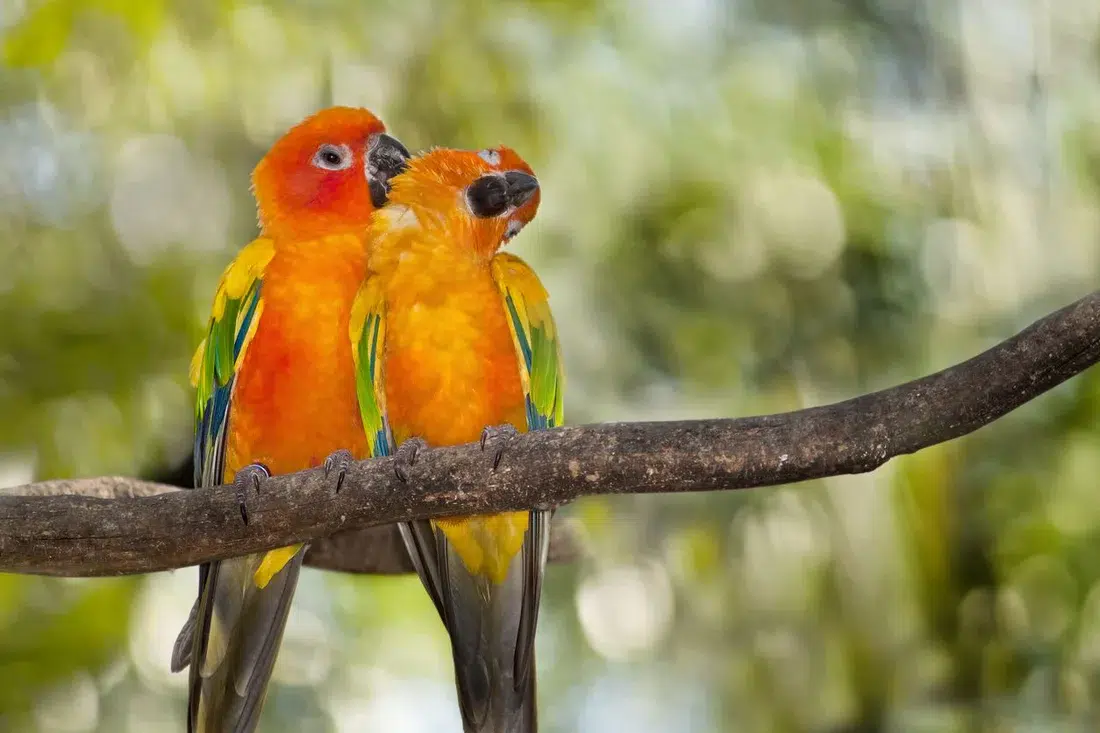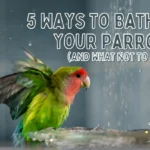
Do Parrots Mate For Life?
Animals form pair bonds to increase their chances of successful reproduction and survival. Parrots, known for their social nature, also seek companionship when choosing a mate. However, parrots can be selective about their interactions and may not get along with just any potential partner. This can be a challenge if you plan to breed or if you’re unable to spend enough time interacting with them.
While parrots and parakeets are considered monogamous, it’s important to understand the nature of their monogamy. Do they fall in love with one partner and remain faithful for life, or is it more about finding a seasonal mate for breeding and raising offspring? If a parrot’s mate passes away, can they find a new partner or will they remain celibate? Can we influence their choice of mate?
Understanding these concepts helps us determine whether our pet parrots or parakeets will be with one mate for life or have the potential to find love again. It sheds light on their social behavior and helps us provide the best environment for their emotional well-being.
Jump To Section
How Parrots Choose A Mate
Mating is an important part of any relationship whether for humans or parrots as it ensures that good traits are passed on to the next generation and that offspring are viable and able to continue the lineage. For parrots and parakeets, mating is mainly done for reproductive purposes, as opposed to recreation. So how do these lovely birds choose their mates and what informs this choice?
A number of things that look very common and ordinary to human eyes are actually strong signals for mating in these beautiful birds. These traits when combined become very strong clues for a potential mate’s genetic superiority, overall fitness, and superior capacity for survival, and could become strong reasons for whether or not a parrot will mate with a potential partner or not. Some traits that can influence a parrot or parakeet’s choice of mate include:
Plumage
Parrots have highly sensitive tetrachromatic eyes that enable them to see the entire spectrum of UV light, thus more color than any human ordinarily can. This means that even though to the average human, they mostly look alike, parrots and parakeets are not only able to differentiate between themselves, but are also able to tell even the slightest differences in the intensity of color as this is a signal of parental caring abilities, good health, breeding success and immunity.
Budgerigars (budgies) tend to prefer mates with glowing rather than dull feathers, and may also prefer mates who preen their plumage to males who do not, as preening enhances the color of the feathers. However, parrots and parakeets rely on more than just looks and physical appearance when choosing mates.
Showmanship
In the animal world, it is common that males are the ones that do the pursuit. Female parrots and parakeets prefer a mate who is able to outdo other males beyond having a beautiful array of colors on his feathers. For example, during mating season, male kakapos usually pick out a prominent place like a hilltop and create a courtship area where they compete for the best spots and start making loud mating calls while booming and hopping on a spot. The females usually pick out the best boomers and hoppers as mating partners. Female budgies also find males with problem-solving abilities more attractive than others.
Birdsong
Music has been known to be a good tool for wooing the female folk since time immemorial. In the world of parrots and parakeets, a good and strong male singing voice is an indicator of good health, strong immunity and success as a partner, all of which are very viable traits for reproductive success.
Regurgitation
For female parrots and parakeets, the most convincing sign of a male’s ability to care for, support and provide for her offspring and her is his ability to regurgitate. Regurgitation is most likely the most important part of courtship for females as they can tell the quality of the mate simply by exchanging food with him. A male who is able to regurgitate a good amount of food passes a strong signal that he will be able to take care of the female and her young if she chooses him.
In addition to all this, an abundance of food and the safety of a parrot’s territorial location are very good indicators of its suitability as a mate.
Till death do us part, or not? – the parrot concept of monogamy
Now that we have a fair understanding of how and why parrots and parakeets form bonds with each other and what influences their choice, it’s time to consider how long their bond can last with their mate of choice. It is a well-known fact that parrots and parakeets are monogamous in nature, however, when we think about monogamy, we tend to picture the human concept of sticking to a partner for the rest of our lives, or putting it simply, honoring the “to death do us part” pact. Parrots and parakeets, on the other hand, practise a different kind of monogamy system known as “social monogamy”.
Social monogamy basically refers to the concept that partners will either remain with their mates for all mating seasons or only until their offspring are big enough to be independent. Social monogamy is mainly important and useful for childrearing and is strictly limited to parenthood in the sense that both parents are equally responsible for the upbringing of their chicks.
This is mostly because parenting is quite tasking and time-consuming for parrots and parakeets as one partner is needed to incubate the eggs in their nest while the other forages for food for the pair and the chicks once they are hatched. As a result, it is necessary that during nesting, one or both parents must be available specifically to ensure that the eggs have the necessary warmth until they are hatched.
Parrots and parakeets are also very loving birds and do not really care about whose chicks they are raising. In this sense, a male parrot can mate with a female from another pair solely for the purpose of reproduction; however, the chick can be reared by a different father. For this reason, it can be a bit difficult to tell if all the chicks in a nest belong to a particular parrot pair, especially when there are more than two couples in an aviary.
So while it is likely that some parrots and parakeets may remain in a mating pair as long as both partners are alive, it is a rare occurrence to find a parrot or parakeet totally lose its willingness to form a new mating bond on account of the absence or death of the other partner.
In the unfortunate event of death
Death is an inevitable part of life and losing a loved one is always a difficult pill to swallow irrespective of whether the relationship was exclusive or open. Despite being “socially monogamous”, both birds can be really shaken up by the loss of their mate. If the surviving partner has been able to form a healthy bond with its owner, the process of grief can be made easier simply by paying attention to and finding time to play and interact with the bird.
However, if the surviving partner was only able to bond with the deceased mate, this could pose a serious problem especially as parrots and parakeets depend on each other for grooming and companionship. In such cases, it may take several months to get them out of the grieving phase, and back to their usual jovial selves again.
This, however, depends on the specie of parrot involved and whether or not it is able to find other interesting cues in the environment to divert its attention from the loss. It is advisable that you do not try to force them to form new bonds immediately as this may be both difficult and frustrating for both parties.
How to tell if your parrot is lonely
Can you tell if your parrot is lonely, and may perhaps need more bonding time with you, or a new friendship that could develop into a suitable pair bond? It is extreme importance that you can identify this because it is a key step to informing what your next line of action should be as regards your pet. Just like anyone who is grieving, lonely or depressed, there are some changes in behavior, appetite and overall demeanor that parrots and parakeets will display that could signal deep sitting loneliness or sadness e.g., becoming unnecessarily irritable or shy. Here are 9 things to look out for to help you identify if loneliness is lurking.
- Change in behavior, appetite and overall demeanor: loneliness, depression and grief are common emotions a lonely parrot or parakeet can feel and, in such cases, they will display some behavioral changes like being unnecessarily irritable and shy.
- Reduced appetite: your parrot or parakeet may suddenly or gradually begin to show signs of loss of appetite depending on the triggers.
- Stress bars: stress bars are lines that run crosswise through a parrot’s feather, resulting in a change in width of the plumage because parts of the feathers on both sides stop growing, while those in the middle section continue to develop. The main reason for the appearance of stress bars is usually poor nutrition, however, loss of appetite resulting from loneliness and stress could also lead to the appearance of stress bars.
- Irritability: parrots and parakeets are usually very upbeat, playful and interactive, however, a lonely or stressed parrot will generally be moodier than their usual self, and are likely to lash out and react angrily even at the slightest provocation. They are even more likely to be irritable if the event causing their loneliness such as the sudden absence or death of a mate coincides with their mating season or other issues that may affect their hormonal balance. You should therefore take extra caution when handling them, especially if your bird is one of the bigger species like macaws, African greys or cockatoos because they are very likely to bite and scratch.
- Destructive behaviors: lonely birds may also become very destructive, and may tear, scratch, or chew on items like furniture or carpets to compensate for playtime with a dead companion or an absent owner. As earlier said, bigger birds are likely to cause more damage than smaller birds like cockatiels or budgies.
- Hiding: in some cases, your lonely parrot or parakeet may hide from you especially if it has not bonded with you and the companion it trusts is no longer around.
- Lack of enthusiasm: lonely parakeets and parrots are less jovial and playful and may remain in their cage or perch for long periods without moving. They may also be less willing to engage in training and other fun activities and may be unusually loud and refuse to be attended to. Despite their unwillingness to engage in activity, they are less likely to be aggressive than irritable parrots.
- Change in vocalization: parrots and parakeets are generally known for their talkative behavior and uncanny ability to mimic sounds. So, if you suddenly observe that your bird is unusually quiet and doesn’t have any physical problems like an inflammation or infection, then the problem may be psychological. Parrots and parakeets can become quiet as a result of stress, loneliness or other psychological issues like depression. Some other species of parrots and parakeets may become more vocal than usual and may make very loud screaming noises to signal distress, pain, irritation, boredom, anger, or loneliness.
- Feather plucking: feather plucking is usually common amongst cockatoos, lovebirds and few other species, and it could be a serious sign of loneliness, and one that should not be ignored because it can lead to serious wounds and infections. You can discover if your parrot is feather plucking by being on the look out for dry patches in spots where feathers should be. This means that as a parrot owner, you must be very observant with regards to your parrots. Of course, feather plucking may be the result of more things than one, and it may be advisable to see your veterinarian if you are unsure of the cause of your parrot’s feather plucking.
Helping a lonely parrot
In the event that you discover that your parrot or parakeet is lonely, here are some things you can do to help:
- Spend more quality time with it, and form a better bond with it by letting it play with you
- Introduce lots of toys and offer them space to channel their anger instead of destroying valuable things
- Get it a companion but ensure that they are placed in different cages. Your parrot may get less bored, but you can’t guarantee that they will become friends or get along eventually.
- You can also increase their frequency of training and try talking to them more regularly. Leave music playing in the background or keep the tv on when you leave the house to help keep them entertained and lighten their mood in your absence.
In attending to them and trying to distract them from loneliness, you should be mindful how and where you touch them as parrots and parakeets tend to begin to see their human owner as a potential mate if you touch them in their “mate only areas”. They consider tickles and touches under their wings, chest, back and toward the rear end of their tail as mating cuddles.
Females may even assume a mounting squat with their tail and rare – side up, while males will try to mount on surfaces or body parts like hands or fingers. Some parrots and parakeets may even start regurgitating for their owners and this is usually not a good sign as it can stop them from forming meaningful relationships and pair binds with potential mates. So, ensure that your touches are generally restricted to their head and neck.
Final Notes
The most important point to remember is that monogamy in parrots and parakeets is strictly restricted to parenting, not love or attraction in the way that humans define it. So, if your parrot or parakeet has lost a mate and is feeling lonely, don’t be confused about what your next line of action should be.
Getting it a new companion could be a good idea, as they could eventually get along and become a couple, but ensure that you do not pressure or force them into bonding as that choice can only be made by the pair involved. Apart from that, you can consider spending more quality time with your parrot to help them get through the loss of a partner.
Parrot Junkie www.parrotjunkie.com
Copyright © 2021-2024. All rights reserved.



Be the first to leave a comment